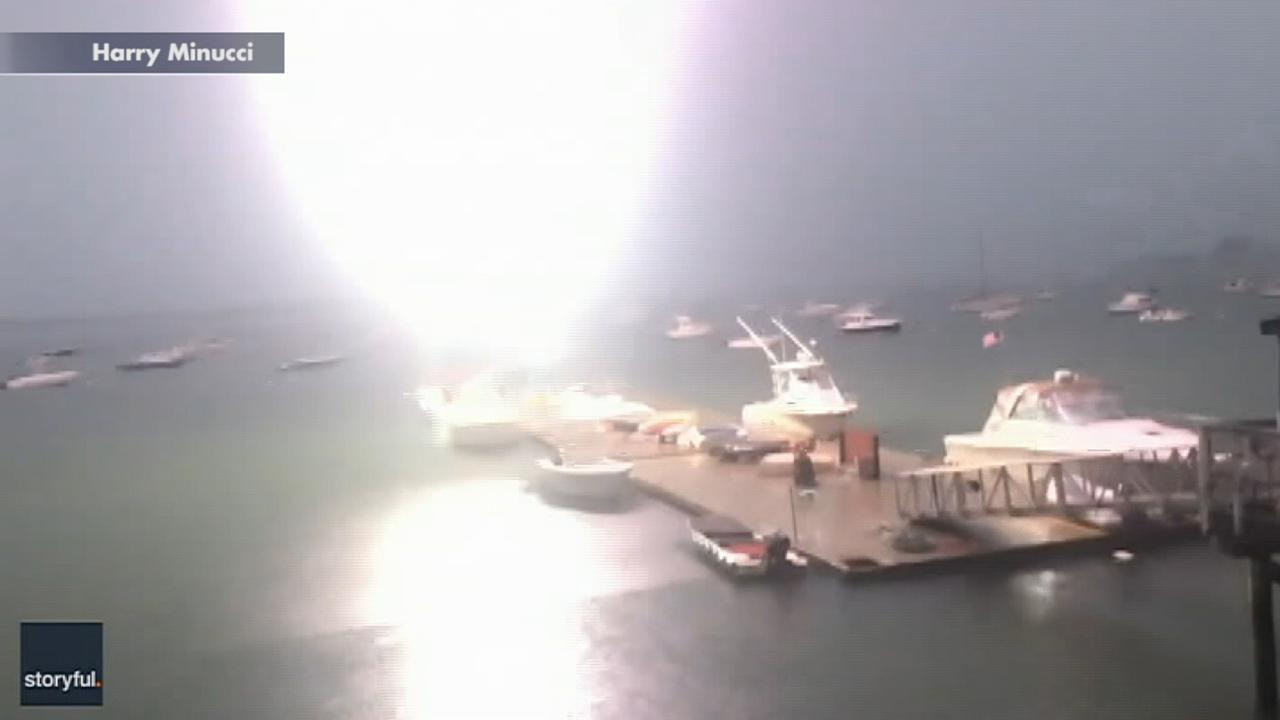What you need to know about lightning safety
Here's what the experts say to do during a lightning strike
In the early hours of June 5 as protesters took to the streets of Washington, D.C. to protest after the death of George Floyd, two Nationals Guardsmen posted near Lafayette Square were hurt in a nearby lightning strike.
The two soldiers were transported to a hospital with injuries that were not life-threatening after being in "close proximity" and "suffering the effects" of the nearby lighting strike within the Lafayette Park perimeter, officials said at the time.
The following day and hundreds of miles away, a Georgia high school senior taking shelter from a thunderstorm in a carport was knocked unconscious and had a seizure after lightning hit. He also survived and was released from the hospital days later.
These three individuals survived but so far this year four others across the country have not had the same fate, all being killed in lightning strikes.
Since National Lightning Safety Awareness Week began in 2001, the average number of deaths has dropped "dramatically," from an average of 55 deaths per year in the U.S. when the campaign first began to just 21 fatalities in 2019, according to the National Lightning Safety Council (NLSC). This year, the week runs from June 21 to 27.
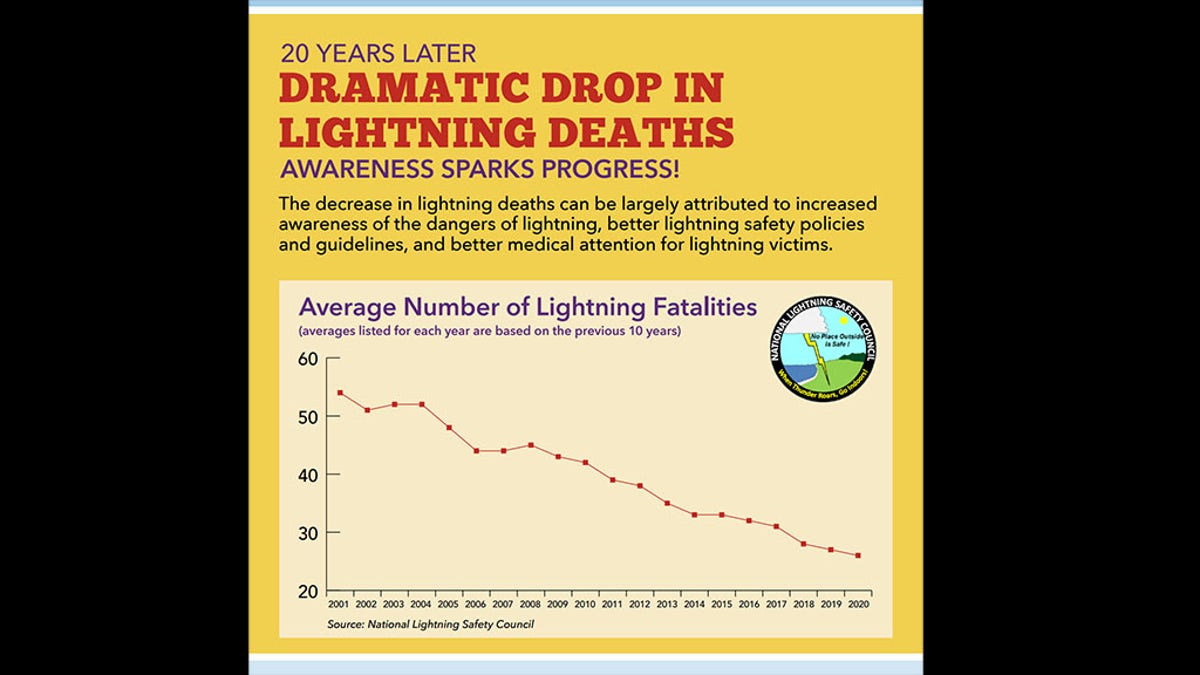
The average number of lightning deaths has tumbled since 2001. (Courtesy Lightning Safety Council)
John Jensenius, a lightning safety specialist with the NLSC, told Fox News on Tuesday that even with an increasing population and same amount of lightning flashes year after year, the number of deaths remains on the decline.
"A lot of it comes down to people are more aware of the dangers and are taking it more seriously," he said.
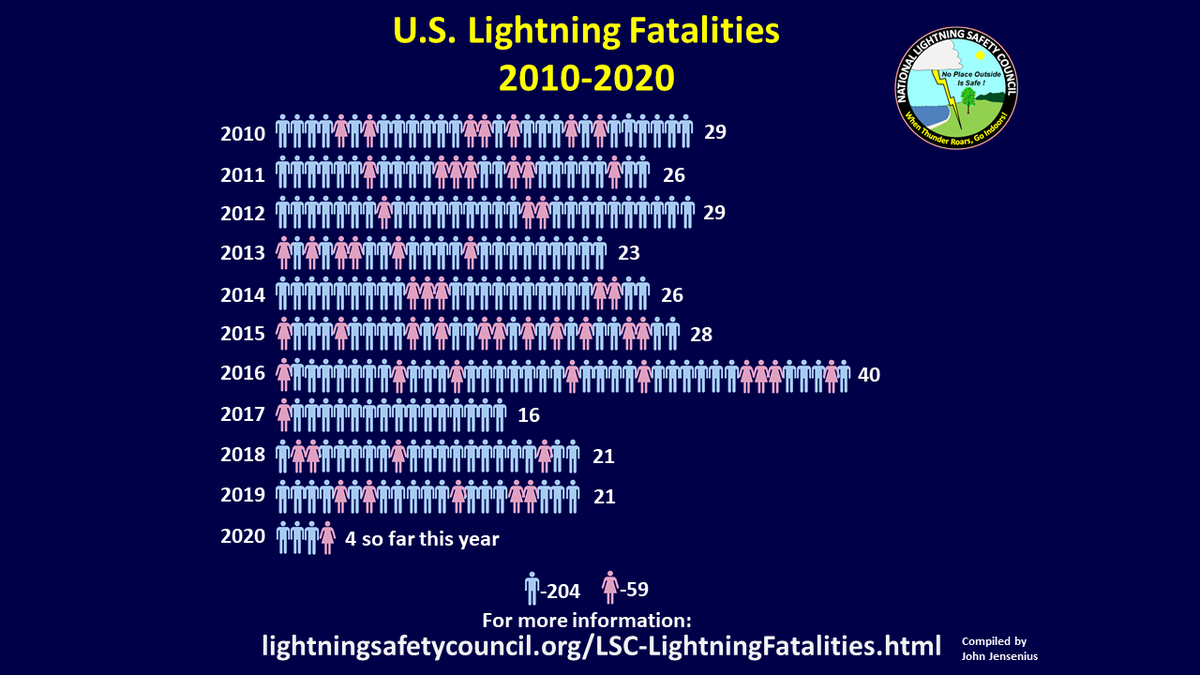
The number of lightning fatalities from 2010 to 2020. (Courtesy National Lightning Safety Council)
That's due to a combination of factors, according to Jensenius. Besides taking it more seriously, people previously may not have understood how close a thunderstorm was to them and if they could hear thunder, they're at risk of being struck by lightning.
LIGHTNING SAFETY: WHAT YOU NEED TO KNOW
Partnerships with media and various organizations, such as sports groups and associations, have also helped increase awareness and set guidelines for outdoor sporting events to keep people safe. Jensenius said more people are able to get alerts on their mobile phones and track thunderstorms. More people are also aware that an individual who has been struck does not carry a charge, and are able to be revived using CPR.
"A lot of it comes down to awareness and knowledge of the fact that lightning is dangerous and you do need to keep inside as soon as the sky looks threatening or you hear thunder," he told Fox News.
Misconceptions about lightning linger
While most have listened to slogans such as "when thunder roars, go indoors," there are still major misconceptions about lightning safety.
LIGHTNING SAFETY: THESE ARE THE STATES WITH THE MOST FATALITIES
Jensenius said he's found that people still believe lightning is still attracted toward metal, even though it typically strikes the tallest object in the area. People would believe that having jewelry or metal in their pockets would somehow make them more susceptible to being struck.

John Jensenius, a lightning safety specialist at the National Lightning Safety Council said the best place to be when lightning strikes is in a substantial building with four walls, wiring, and plumbing. (iStock)
"It's simply the fact that they are outside," he said.
ACTIVE HURRICANE SEASON FORECAST, CORONAVIRUS ADDS NEW TWIST TO DISASTER RESPONSE FOR AT&T
Another myth is that rubber protects someone from lightning, since being in a vehicle during a thunderstorm is safer than being outside. But according to Jensenius, that's due to a hard-topped metal vehicle and its metal shell being able to distribute the electric charge if it's struck.
People also misjudge their distance from approaching storms, thinking that the lightning rise may be much further away than it actually is.
"They are in danger as soon as they hear a distant rumble of thunder," he said.
Some activities lead to more deaths than others
Between 2006 and 2019, a review of some 418 fatal lightning strikes found that 62 percent of deaths were linked to leisure activities.
Fishing has accounted for 40 of those deaths, while being at the beach, camping, and farming or ranching may up the largest portion of deaths, according to data reviewed by the NLSC.
There's a pattern to most of those, according to Jensenius.
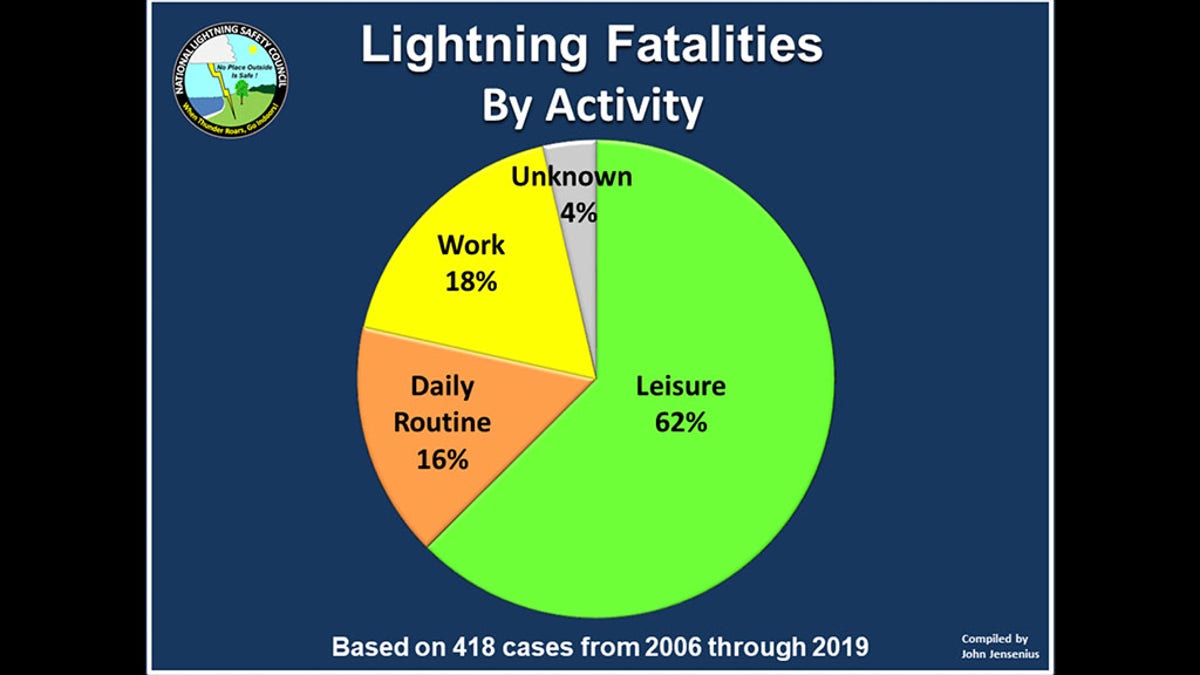
A breakdown of lightning fatalities by activity from 2006 through 2019. (Courtesy Lightning Safety Council)
Activities where people may be outside and not know if a storm is approaching when they are camping or fishing with a motor on a boat that drowns out the sound of thunder are factors to consider.
LIGHTNING SAFETY: THESE ARE THE ACTIVITIES LINKED TO THE MOST DEATHS
If someone is at the beach, the sound of the surf may also drown out the distant rumbles of thunder.
CLICK HERE FOR MORE WEATHER COVERAGE FROM FOX NEWS
"The key is if there's any threat at all, rumble of thunder or what looks like a threatening sky, you need to be able to get into a safe place very quickly," he said.
Survivors still face devastating injuries
Only one out of 10 people that are struck by lighting actually die from their injuries, according to Jensenius.
The vast majority do survive but can still have devastating injuries. Thousands are thought to have survived lightning strikes during the 19-year-old safety campaign.
When Jacob Smith in Georgia was struck by lightning on June 6 as he was leaning on the carport, he told WGXA-TV he felt the electricity enter his body through his left rib and exit through his right hand where he had grabbed a metal rail.
"You could tell where I was grabbing on where the metal was burning," he told the television station.
He spent two days in the burn unit at a hospital in Augusta after also having a seizure, to which he also had some paralysis in his arm before slowly gaining back strength.
Marcus Griffin was knocked unconscious when a lightning bolt hit behind him on June 8, he said he "blacked out" and woke up in the dirt.
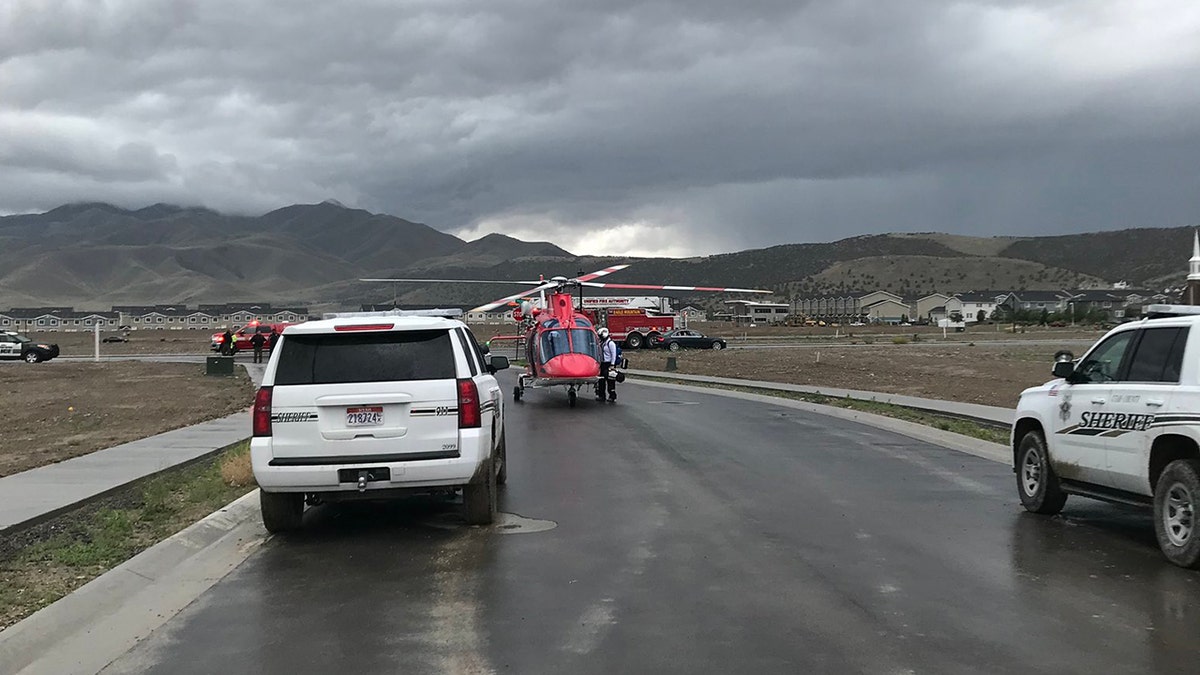
Marcus Griffin was knocked unconscious after a lightning strike nearby as he was hiking earlier this month near Eagle Mountain, Utah. (Utah County Sheriff's Office)
“It felt like a really bad 'charlie horse' in all of my calves, on both sides and I couldn’t get my legs underneath me," he told FOX13.
SEVERE THUNDERSTORM DANGERS: WHY YOU SHOULD TAKE WARNINGS SERIOUSLY
Doctors told him he had markings on his neck and chest that were consistent with a lightning strike, in addition to cuts and bruises from when he hit the ground.

Marcus Griffin was knocked unconscious after a lightning strike nearby as he was hiking on Sunday near Eagle Mountain, Utah. (Utah County Sheriff's Office)
Others have faced life-changing injuries.
A collection of stories from lightning victims submitted to the National Weather Service (NWS) reveals people suffering from severe headaches, memory loss, post-traumatic stress disorder and chronic pain.
Jensenius said lightning strikes don't impact just the individual, but also the family that may have to take care of the person for the rest of their lives.
The safest place in storms
When thunder does roar, there's a reason why experts say the best place to be is indoors.
Jensenius said the best place is in a substantial building with four walls, wiring, and plumbing. That's because if it's struck by lightning, it will follow the plumbing and wiring to the ground.
"That keeps you safe, if you aren't in contact with wiring or plumbing," he said.
Staying away from windows, doors, touching doorknobs to the outside as well as avoiding taking showers or baths when lightning is around is also key to avoiding a dangerous situation.
CLICK HERE FOR THE FOX NEWS APP
Typically in 2020, there would be an average of seven deaths by late June. With only four so far, Jenisisus said that the group has been fortunate to cut the toll in half over the years, but there's no reason it could stay there if people slack off.
"It could go up," he said, "if people are not as careful anymore."


